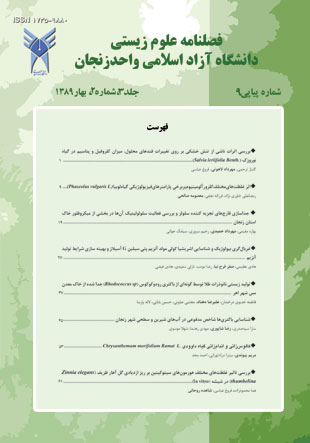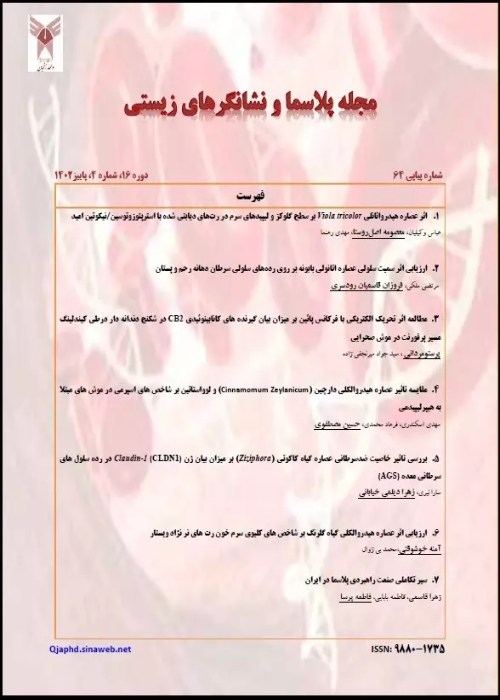فهرست مطالب

نشریه پلاسما و نشانگرهای زیستی
سال سوم شماره 2 (پیاپی 15، بهار 1389)
- بهای روی جلد: 20,000ريال
- تاریخ انتشار: 1389/04/01
- تعداد عناوین: 8
-
Page 1Drought stress is considered as a major limiting factor in plant growth and development.this study was conducted to determine the effect of various levels of drought onS.leriifolia.The study was carried out as a complete randomized design with 4 replicationsin pot and greenhouse condition.The drought Levels were included 0,-2,-4,-6,-8Bar. Soil misture various potentials was measured using a pressure plate devise.After six weeks of drought treatment, variations in chlorophyll,soluble sugars, pottasium,fresh and dry weight of root and shoot, shoot lenght were measured. Resultshowed chlorophyll a,b contents, fresh and dry weight of root and shoot and shootlenght significantly decreased but soluble sugars content in root and leaf,potassiumconcentration in shoot increased with increasing levels of drought stress. Increasing ofsoluble sugars and pottasium content possibly indicate the establisshment of a tolerancemechanism to drought stress in Salvia leriifolia Benth.
-
Page 9The effects of AlCl3 with different concentrations of 0, 50, 150, 300, 450, 600, and750 μM on certain physiological parameters in bean plants (Phaseolus vulgaris L.) during25 days growth period (15 days Treatment) in hydroponic cultivation environmentwere studied. With increasing aluminium chloride, carbohydrate and protein contentswere increased. In high concentrations of AlCl3, peroxidase activity increased, however,in 50 and 150 μM AlCl3 in comparison with control, peroxidase activity decreasedand also with increasing aluminium chloride, catalase activity increased in comparisonwith control, but in 600 and 750 μM AlCl3 catalase activity decreased.
-
Page 19Cellulose is the most abundant biopolymer on biosphere and one of the most importantconstituent in plant cell wall. Biodegradation of cellulose in soil has an importantrole in Carbon flow and changing fixed Carbon to CO2, and in producing stable biologicalproducts and bioenergy. In this research fungus were isolated from soil of Zanjanand Abhar, due to great potential of soil mycoflora in degradation of cellulose. Thenisolates were grown in selective media containing Avicel as Carbon source and theircellulolytic activity were measured by DNS method. Among 67 samples, Aspergillusniger is the the most prevalent fungus between isolates and it has the highest activityamong the isolates of Zanjan and Abhar.
-
Page 27
Penicillin G acylase (PGA) of Escherichia coli is one of the most widely used enzymesat industrial scale. It is used to hydrolyse penicillin G to 6-aminopenicillanic acid, anessential intermediate in the production of semisynthetic penicillins. Due to high industrialimportance of PGA, numerous efforts have been made towards screening forstrains overproducing this enzyme. The objective of this study was to screen clinicalsamples for isolation and identification of E. coli strains producing PGA enzyme.The E. coli bacteria isolated from clinical samples were screened for PGA activity usingthe bioassay method. This method is based on the use of Serratia marcescens whichis sensitive to 6-APA but comparatively resistant to benzylpenicillin. After primaryscreening, the PGA production in positive isolates was verified by biochemical assay.Finally, the effects of incubation time, temperature, PAA concentration and media PHon PGA synthesis were studied and the optimum conditions for process were determined.
-
Page 37Nanobiotechnology is a novel science in the fields of industry, medicine and biology.Nanoparticles especially gold nanoparticles are subjected to have several applicationsin diagnosis and therapy of cancer.Ever increasing pressure to develop environmentallybenign nanoparticle synthesis has lead to an interest in biotransformations as a route togrowth of nanoscale structures. In this study, we have investigated biosynthesis of goldnanoparticles using Rhodococcus. sp isolated from Ahar copper mine (in north-west ofIran). The results showed the intracellular/ extracellular synthesis of gold nanoparticlesby reaction of 1 mM aqueous HAuCl4 incubated at pH 7 after 24 h with Rhodococcus.Sp. The UV–vis and XRD of the bacterial as well as chemical prepared Au NPs wererecorded. Transmission electron microscopy (TEM) micrograph showed the formationof gold nanoparticles with average size of 50 nm.
-
Page 45Water quality is usually determined through detection of a few microbiological parameters,typically fecal indicator such as total coliform (TC), fecal coliform (FC), E.coli, Clostridium perfringens, Streptococcus faecalis(FS). Fecal indicators are found in elevated concentrations in human and animal feces. Water quality samples were analyzed for five bacteria, TC, FC, E.coli, C.perfringens, S.faecalis. Goal of this study TC, FC, E.coli, S.faecalis measured by the MPN method at this study and C.perfringenswas was detected by useing of litmuse milk and stormy fermentation. Results show that the number of TC less than 1000 MPN/100ml in 60% of samples and FC lees than 1000 MPN/100ml in 77% of samples and S.faecalis in 77% of samples was 3 MPN/100ml. Ratio FC/FS in 49% was more than 4 and also there was C.perfringens in 54% of samples. Present of fecal indicator bacteria in water indicates potential adverse health effects for indivduals or populations exposed to this waters. we conclude that there is a risk of infection for users of Zanjan,s fresh and surface waters.
-
Page 53The effects of different cytokinins (benzyl amino purine(BAP), Kinetine (Kin) incombination with different auxins(Indole butyric acid(IBA), 2,-dichlorophenoxy aceticacid (2,4-D) were investigated on callogenesis and organogenesis of Chrysanthemummorifolium Ramat L. Leaves explants were cultured in the MS medium supplementedwith different auxins and cytokinins. Results of using IBA and BAP in the media indicatedthat calli which were taken from medium with IBA (2 mgL-1) and BAP (0.5mgL-1) produced roots and callus of IBA (1 mgL-1) and BAP (1mgL-1) produced shoots.By using 2,4-D and Kin in the medium, rhizogenesis were occurred in the media supplemented with 2,4-D (0.5, 4 mgL-1) and Kin (2 mgL-1).Subculture of calli increasedrooting. Calli of medium with 2,4-D (0.5 mgL-1) and Kin (2mgL-1) produced shoot afterthe first subculture in the free hormone medium. In the 2,4-D and BAP treatments,maximum level of callogenesis and rhizogenesis were achieved. Calli in the mediumsupplemented with 2,4-D (0.5 mgL-1) and BAP (1mgL-1) produced roots and shoots.
-
Page 61
For studing of the effects of plant growth regulators on in vitro culture of Zinnia elegans, an experiment has been done by using different concentrations of Cytokinins (benzyl amino purin and kinetin) (1,2,3 μM) in Murashig – skoog (MS) culture medium by factoryel manner. The applied explants were embryos with halfed dicotiledons, in which, the percentage of their germinating (seeding), number and length of their leaves, length of shoots and roots were considered. The majority number of leaves were seen in BAP hormone in concentration of 3 μM. The best concentration for increasing the length of leaves was observed in BAP hormone in concentration of 2 μM. The branch formation was also seen in BAP hormone in 2 μM concentration. The most increase of stem length was related to BAP hormone in 1 μM concentration and the most increase of root length was related to Khn hormone in concentration of 1 μM.


